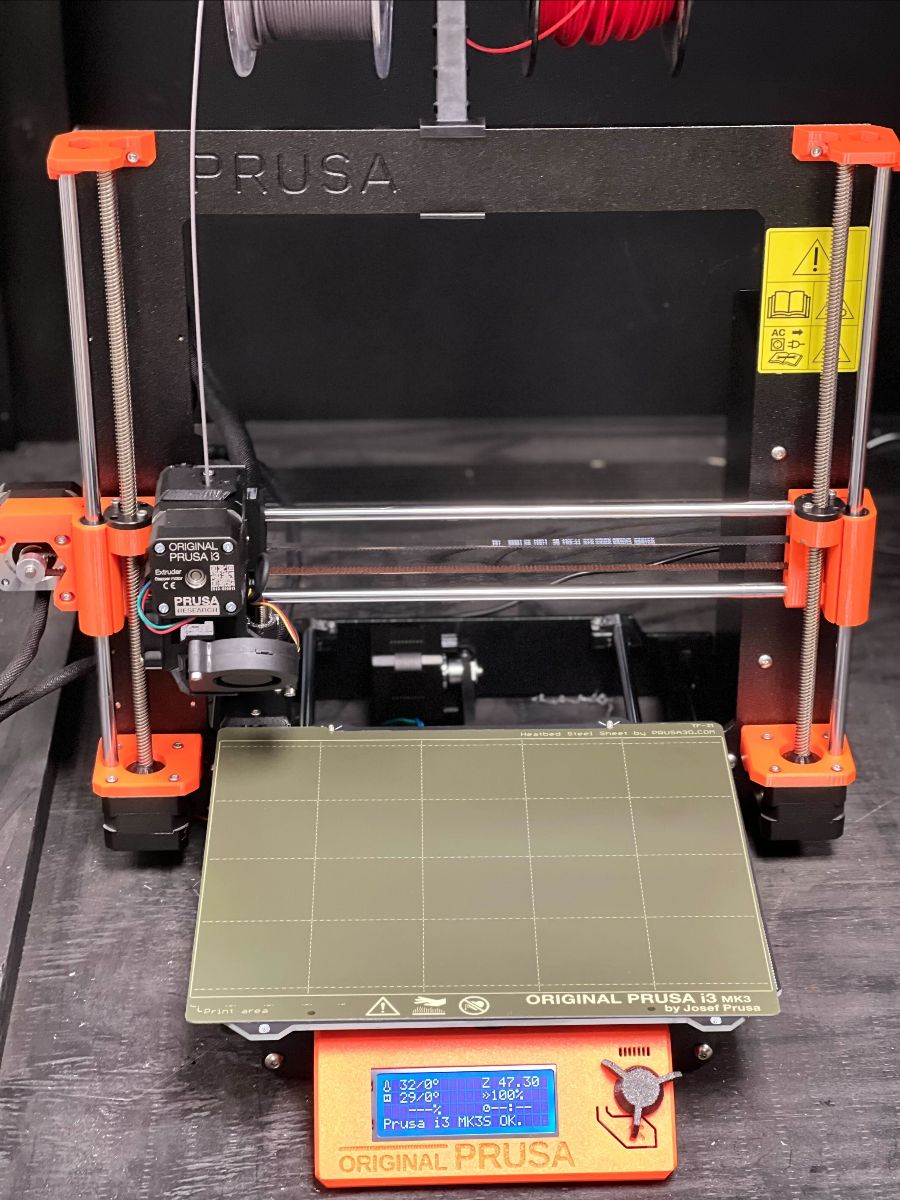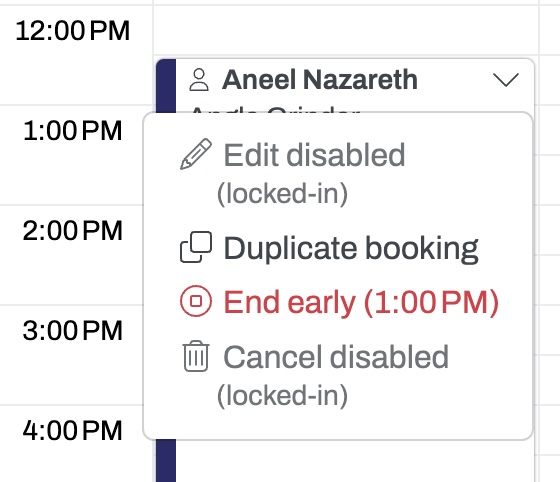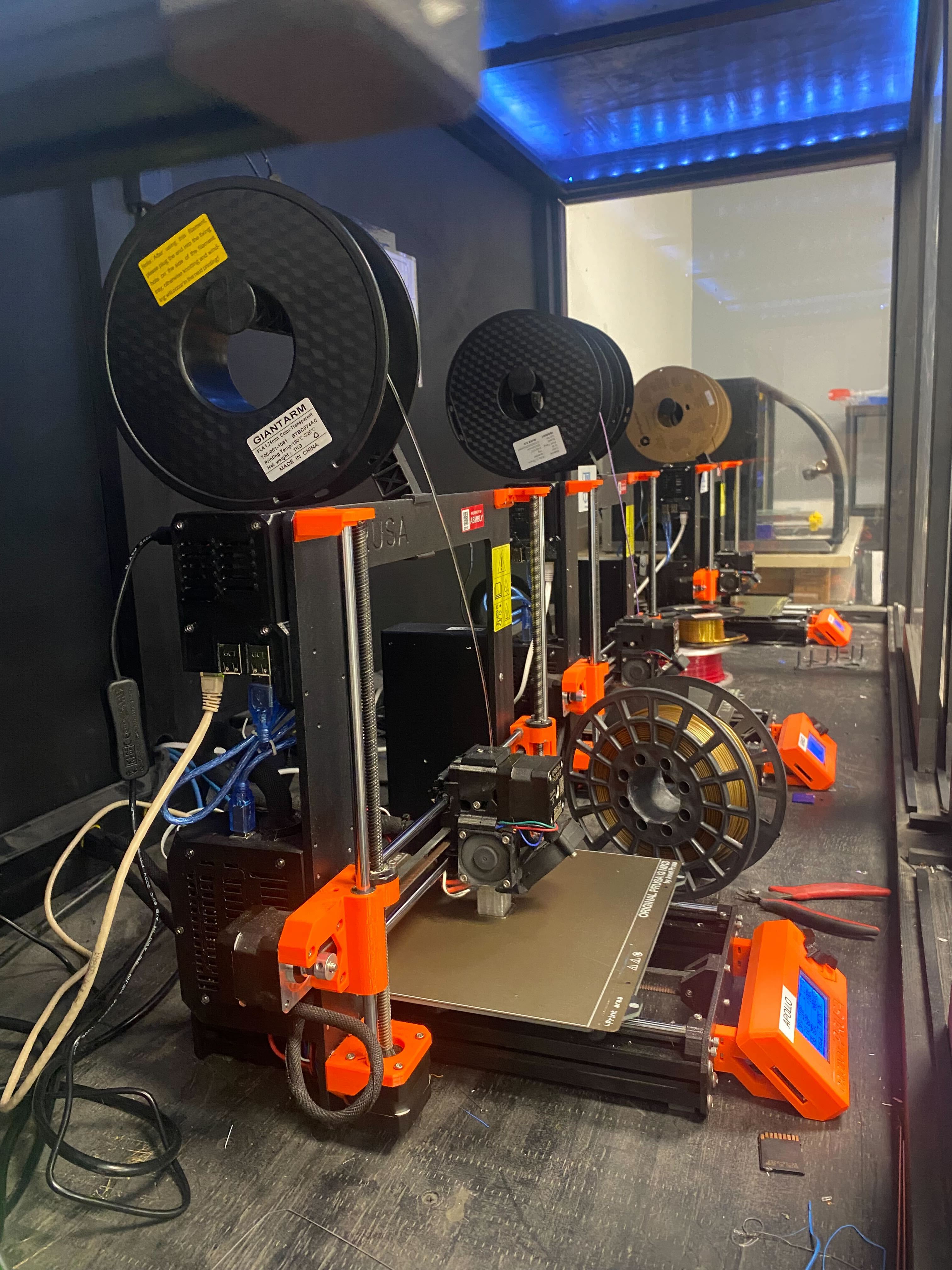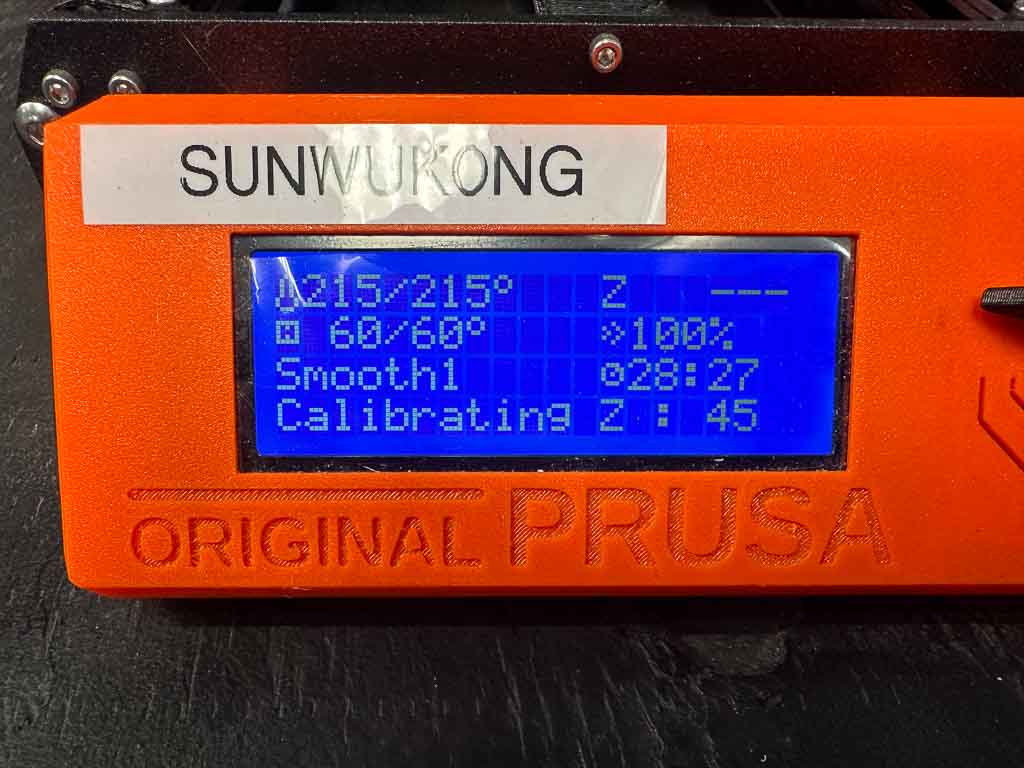BambuLab P1S
![]() Members must complete the BambuLab P1S: Techniques Class before using this tool
Members must complete the BambuLab P1S: Techniques Class before using this tool
Maintenance
This tool is owned by Michael Dixon and hosted at Asmbly for members to use. Please submit a problem report if maintenance is required.
Asmbly has one Bambulab P1S 3D Printer and one Automatic Material System (AMS). Located in the in the Multi-Purpose Room's far corner between the Prusa printers and resin printers. The P1S is named Poseidon.
|
Safety
Universal Safety
- Be aware of your surroundings, especially when handling large materials.
- Do not approach anyone operating equipment. Stand patiently in their field of view.
Equipment-Specific Safety
BambulabP1S: Techniques is required to use this tool.
No special PPE is required to use this tool.
Booking Policies
Time booked for 3D printing in Skedda does not count against your weekly Asmbly hours. It is fine for a print to continue while Asmbly is closed.
- Book all of the time you need. Only print during time that you have booked. Don’t start prints that will go beyond your booked time. If your print has been paused or stopped because of a problem, don’t resume or restart it if it will go beyond your booked time. If time is available after your booked time, feel free to book more time to finish your print. If another member has already booked time that your print would need to use, and you contact them and get their approval, you may finish your print. However, if you do not manage to contact them, or if they do not agree to let you continue, then do not start, resume, or restart prints that would go into their time.
- Time you book is yours. If you arrive for your booked time and a print is ongoing, you may stop that print. If a print only has a few minutes remaining, it would be nice if you let it finish, but you are not under an obligation to do so.
- Give back time that you don’t need. If you realize you’ll be late, change your booking to start when you’ll actually be ready to start. If your print ends early, end your booking early in Skedda.
- Don’t let time go to waste. There is a two hour grace period at the beginning of a booking. If the booker is not present after two hours and the printer is still idle, another member may claim the remainder of the time on a first-come, first-served basis. Email [[2]] to let us know that this happened. There is a 30 minute grace period after the completion of a print. If the booker is not present and the printer is idle, another member may claim the remainder of the time on a first-come, first-served basis. Email [[3]] to let us know that this happened.
Etiquette
If you come in for your scheduled time and a print has finished, feel free to move it and any filament on the machine to the table to the left of the Prusa enclosure.
If you are in the 3D printing area and see a print in progress that is obviously failing, it is a good idea to stop the print so that it stops wasting filament. Try to contact the person who has that printer booked in Skedda to let them know. Discourse is a good way to do that, if you don't already know them.
Use Case
The Bambulab P1S is a good printer to produce small and medium sized objects using up to 4 filaments with the AMS. The filaments can be mapped to the model using Bambu Slicer, Bambulab's proprietary slicer software.
If you need to print larger things, consider splitting the models into smaller parts or use the Prusa XL.
If you need to print in ABS, ASA, or other materials that print better enclosed, please make sure to preheat the bed with the door closed for a minimum of 30 minutes at 100C.
Use Skedda to reserve time on the specific printer.
Materials
Acceptable Materials
Many types of 1.75mm filament will work with this printer. Please note that when using cardboard spools in the AMS, members MUST place a printed spool ring over the spool edge to avoid cardboard dust buildup inside the AMS.
This printer is not currently equipped with an abrasion-resistant nozzle. This means that filaments with include additives such as glow-in-the-dark powder (strontium aluminate), carbon fiber, glass fiber, wood, or metal cannot be used with this machine.
Material Limits
Print volume is 256mm x 256mm x 256mm (10" x 10" x 10")
Consumables
You are responsible for providing your own filament. There are many places to order from, including MatterHackers, Prusa, Polymaker, and Amazon. We are not currently aware of any place to buy filament locally, but if you know of one, we'd be interested!
If using a micro SD card to start a print, one is available for use and is always inserted into the P1S. However, if you find yourself printing from micro SD frequently, please consider bringing your own.
Asmbly currently only provides a textured PEI printing sheet. Asmbly also provides cleaners for the sheet: Isopropyl Alcohol (usually in a squeeze bottle with the printer tools) and Dish Soap (in the coffee area just outside of the multi-purpose room).
Operation
Controls
Emergency Stop
If you see or hear something going terribly wrong with the printer, you can immediately stop it by shutting off the power switch located at the back bottom right of the machine. Examples of situations where you would want to do this: the nozzle is contacting the steel plate, the printer is trying to move the head beyond its rails, there is a burning smell or smoke visible, etc.
Control Panel
The printer has a control panel that can be used to do things like preheat the machine, loading and unloading filament from the rear spool holder, pause/stop a print, and start a print from an SD card.
To see the full list of screen controls, please visit [4]
Printing from the SD Card
The P1S DOES NOT have a hot-swappable micro SD card. The card must be cleared for ejection via the screen before removing it from the printer.
The file to be printed must be in the root directory of the micro SD card (do not store it in a folder).
Follow this guide: [5]
Stopping or Pausing a print
You can stop a print from either the Devices menu in Bambu Slicer or the control panel. If you stop or pause a print from Bambu Slicer mid-print, it will not move the nozzle clear of your print.
Firmware Upgrade Warning
Ignore messages about a firmware upgrade warning.
Settings and Adjustments
Filament
Make sure that your slicer settings take into account the particular kind of filament you are using.
If you need help loading or unloading filament from the rear spool holder, please visit [6] or [7], respectively.
Print Bed Sheet
There is a chart on the enclosure that lists which sheets are best for each kind of filament, or check Section 6.3.2 of the handbook
Make sure that the printer knows which sheet is on it. The sheets have different thicknesses, and you may not get a good first layer if the wrong sheet is selected.
Cleanup
Universal Cleaning Guide
- Return the equipment to neutral.
- Sweep up any dust and debris around the tool, your table top, and the floor - both in the equipment area and your work area.
- Clear the floor of any tripping hazards, like power cords.
- Empty trash cans and dust collectors that are halfway full or more into the Asmbly dumpster behind the workshop.
- Leave the shop 110% better than you found it.
Tool Specific Cleaning Guide
- Remove any scraps of filament from the enclosure
- Return any tools you used to the tool caddy
- Make sure the steel sheet you used is clear of any leftover filament
- Check the waste chute after multimaterial prints and dispose of any purged filament
Resources
Manual
- [8]
- Bambu Slicer
- 3D Filament Temperature Tower - Fine tune your temperature settings for a particular filament
Discourse Links
External Resources
Places to find models to print:
- STLFinder
- Thingiverse
- Printables
- Yeggi
- Buy from makers on Etsy
- MyMiniFactory for DnD miniatures
Places to buy filament:
- Polymaker
- Amazon
Troubleshooting
Common Problems
Model not sticking to the sheet
If you are having trouble with getting your first layer to stick properly try these:
- Double check that the printer is configured for the right sheet
- Clean the sheet (wait for it to cool down if it is hot) with Isopropyl Alcohol (in a squeeze bottle with the other tools)
- Wash the sheet with hot water and dish soap at the coffee area sink. Make sure the sheet is completely dry before reinstalling it.
- If printing in ASA or ABS, ensure that the chamber is preheated by heating the bed to 100C for a minimum of 30 minutes prior to starting a print.
- Contact a steward
Nozzle has plastic stuck to it
This often happens as a result of the model not sticking to the sheet, and causes problems when you try again.
- Lower the print bed via the printer screen or Bambu Studio so you can see the underside of the nozzle
- Touch some cool plastic to the still-hot plastic on the nozzle. It should stick and let you pull the mess away
- Heat the nozzle above the printing temperature for your filament, for example, try 250° for PLA, which normally prints around 215°. Wait for the nozzle to heat up and let the melted plastic drip off of the nozzle
- Use the tweezers from the tool caddy to grab larger lumps
- Use the brass brush in the tool caddy to wipe the heated nozzle
Other
If you are unsure, it is always best to contact a steward and fill out a problem report
Maintenance
The information below is primarily for stewards.
Regular Maintenance
The lead screws should be cleaned and lubricated regularly.
Follow this guide: [9]
Moving the printers
Power down the P1S by shutting off the red power switch at the back, unplug the power cable, and move the printer.
Rebooting Procedure
Since the P1S is not connected to Octoprint, rebooting is as simple as turning on the back power switch.
Z Problems
If the printer is printing too far away or too close to the bed for the first layer (to see what these look like look at Section 6.3.9 of the handbook), try the following:
- Make sure the printer knows which sheet is on the bed. Different sheets have different calibrations
- Make sure the bed is seated properly and not warped.
- Make sure there is no debris on the nozzle tip when automatic calibration is being performed at the start of a print.
Perform Auto Calibration
Navigate to the calibration option using the screen or Bambu Studio: [10]
Filament Sensor Inspection
If the following happens:
Printer sends the error message "Filament failed to send to the extruder", but there is filament in the tube above the toolhead.
When using the AMS, printer sends the message "Please pull the filament from the external spool", but there is no filament in the tube above the toolhead.
The printer sends the message "Please insert the filament into the port until it can no longer be pushed", but the filament has entered the extruder.
Please follow this guide: [11]
Hotend Clumping
In the event of hotend clumping, please follow this guide: [12]
Bed Not Heating
In the event that the bed does not heat up, please follow this guide: [13]



